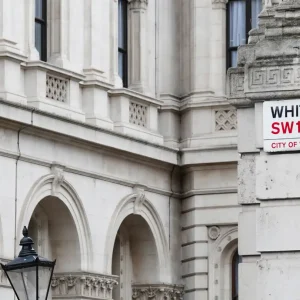
Public sector organisations are being advised to use higher-level cloud services by the UK government after it updated its cloud-first policy. Departments are also being encouraged to look to global providers as part of the updated guidance. Industry experts have described the latest policy updates as “progressive” but some worry that it overlooks open source and sustainability.

Guidance for the government’s cloud-first policy was updated this week, adding nine principles that public sector organisations should abide by when selecting vendors. The Cabinet Office told Tech Monitor that minor changes were also made to reflect the creation of the Central Digital and Data Office (CDDO) and moving processes away from the Government Digital Service (GDS).
The updated policy focuses on using Software-as-a-Service (SaaS) as a valid alternative to public cloud. For anything that has to remain on-premises, the policy states that organisations should use Crown Hosting, a joint venture between the Cabinet Office and Ark Data Centres. The policy says this is the “best option” to allow for rapid contracting and reducing risk and effort.
It also points to departments using cloud services that have an overseas or global presence.
One tech expert told Tech Monitor that these principles help the CDDO and central government keep public sector organisations in line, establishing “guard rails” rather than allowing each department to do its “own thing”. However, as previously reported, this attitude from public sector organisations is down to culture.
Government directs departments to always use Public Cloud first
Prior to the change, the central government was less direct with its guidance over public cloud use, simply stating that departments should “consider cloud solutions before alternatives”. However, in its latest iteration, the government has said that organisations in the public sector should “default to public cloud first”. A similar stipulation has been made for SaaS.
Fabricio Brasileiro, global director, alliances and MSP, Forescout Technologies, says that this move by the government could have several benefits to wider society: “The government [is aiming] to deliver technology quickly, cost-effectively and with reduced risk, ultimately benefiting society,” he says.
By standardising cloud configurations and adopting security measurements by design, Brasileiro says it could ensure interoperability and the protection of its systems and services. “This enables seamless collaboration between government agencies, improving efficiency and effectiveness in public service delivery,” he explains.
The move by the Cabinet Office and CDDO to encourage seamless collaboration would help the latter meet its 2025 goal of achieving both better data-sharing, and departments using more modern technologies. A report by the National Audit Office (NAO) earlier this year said it was currently too early to tell if the CDDO would achieve its goals by the deadline.
“Many business leaders [in government] do not yet have the expertise required to comprehend and tackle the challenges the civil service faces in a digital age,” the NAO report said.
Cloud principles push public sector organisations to hyperscalers
Nitish Mittal, partner at the Everest Group, told Tech Monitor that the government wants to encourage and scale adoption of hyperscalers in other parts of the public sector. It has already started the work by establishing “foundational agreements” through the Crown Commercial Service (CCS).
“CCS’s arrangements with the cloud hyperscalers aim to provide a pre-negotiated or pre-agreed set of pricing and a services catalogue, which attempts to reduce negotiations and contracting at each program’s level,” he said. “The real test will be how this is implemented and scaled.”
Hyperscaler cloud providers such as Amazon’s AWS and Microsoft Azure are already well-known to public sector organisations. As reported by Tech Monitor, AWS secured nearly £600m in public sector contracts between 2017 and 2022.
The benefit of the hyperscalers is that they can meet the demands of larger enterprises while also scaling to increased demands as and when it happens.
Mittal says that while the cloud-first updates do address the point on cloud economics, closer attention will be needed for costs: “[Departments] will need to pay closer attention to cloud usage and total economics as cloud bills can quickly escalate unless monitored closely,” he says.
Cloud-first policy neglects sustainability and open source
Amanda Brock, CEO of open source tech advocacy group OpenUK, says that there is an absence of thought for the environment and the potential benefits of open source.
She said that the use of open source in data-centre environments reduces the hardware required and can make “very significant reductions” in departments’ carbon footprints.
“The same is true of our cloud computing choices,” she explains. “The new strategy doesn’t acknowledge open source, which is not entirely surprising, but it is a critical dependency of the provision of cloud, particularly public cloud.”
Brock says that policymakers and politicians need to understand the importance of open source when making decisions around Cloud in the future: “The strategy mentions the re-use of code and probably relies upon the decade-old UK Open Source First Strategy in the public sector rather than calling this out, so more clarity on how this works in practice would be wise,” she says.






